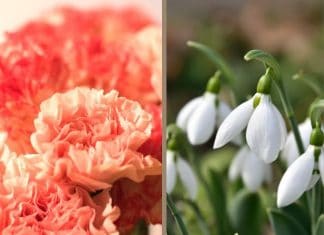
Birth flowers, a tradition that transcends cultures and generations, offer a unique way to celebrate and reflect on individual characteristics and milestones. Each month is associated with a specific flower, carrying unique symbolism and meaning. Deep-rooted in history and folklore, these floral emblems connect nature and human emotions.
Birth Flowers
These flowers are classified as birth flowers by months:
January Birth Flowers
February Birth Flowers
March Birth Flowers
April Birth Flowers
May Birth Flowers
June Birth Flowers
July Birth Flowers
August Birth Flowers
September Birth Flowers
October Birth Flowers
November Birth Flowers
December Birth Flowers
![]()
Birth Flowers & Their Symbolic Meanings
| January Flowers | Carnation, Snowdrop | Love, fascination, distinction (Carnation); hope, consolation (Snowdrop) |
| February Flowers | Violet, Primrose | Faithfulness, humility, spiritual wisdom (Violet); young love, modesty (Primrose) |
| March Flowers | Daffodil, Jonquil | New beginnings, rebirth, respect, unrequited love (Daffodil); affection returned, desire (Jonquil) |
| April Flowers | Daisy, Sweet Pea | Innocence, loyal love, purity (Daisy); blissful pleasure, goodbye, departure (Sweet Pea) |
| May Flowers | Lily of the Valley, Hawthorn | Sweetness, humility, returning happiness (Lily of the Valley); hope, supreme happiness (Hawthorn) |
| June Flowers | Rose, Honeysuckle | Love, honor, faith, beauty, timelessness (Rose); bonds of love, sweetness (Honeysuckle) |
| July Flowers | Larkspur, Water Lily | Levity, lightness, ardent attachment (Larkspur); purity of heart, rebirth, divinity (Water Lily) |
| August Flowers | Gladiolus, Poppy | Strength of character, integrity, persistence (Gladiolus); eternal sleep, oblivion, imagination (Poppy) |
| September Flowers | Aster, Morning Glory | Wisdom, valor, faith (Aster); affection, unrequited love, mortality (Morning Glory) |
| October Flowers | Marigold, Cosmos | Creativity, passion, resilience (Marigold); order, peace, tranquility (Cosmos) |
| November Flowers | Chrysanthemum, Peony | Loyalty, honesty, longevity, joy (Chrysanthemum); prosperity, good fortune, bravery (Peony) |
| December Flowers | Narcissus, Holly | Hope, wealth, self-admiration, vanity (Narcissus); foresight, domestic happiness (Holly) |
![]()
Frequently Asked Questions
What is the concept of birth month flowers?
Birth month flowers, similar to birthstones, involve associating a specific flower with a particular month of the year. These special flowers represent the traits and characteristics of individuals born that month. Depending on the month, there may also be two birth flowers per month.
Why do we have birth flowers for each month?
Just as every month has a stone, every month also has a flower. The belief is that the different birth flowers symbolize the different qualities individuals born in a specific month possess. They are a beautiful way to celebrate people’s individuality and the month they were born.
Can there be two birth flowers per month?
Yes, some months are associated with two birth flowers. Each flower has a slightly different meaning, allowing for more personalized symbolism. For example, the primary birth flower for January is the Carnation while the secondary birth flower is the snowdrop.
What does the Rose, a birth month flower for June, symbolize?
The Rose, one of the world’s favorite flowers, is a birth flower for the month of June. It symbolizes love, gratitude, appreciation and admiration. Some even delve into the language of flowers, linking different colors of the rose to nuanced meanings.
Is the Marigold also a birth flower?
Yes, the brightly colored Marigold with its robust bloom is one of the two birth flowers for the month of October. It represents undying love and in the language of flowers, a desire for wealth and success.
What is the birth flower for May?
May celebrates the Lily of the valley as its birth flower, along with the hawthorn. The fresh and fragrant lily of the valley represents sweetness and humility in the language of flowers.
What are the two birth flowers for January?
January is represented by two birth flowers, the carnation and the snowdrop. Carnations are believed to symbolize love, fascination, and distinction. Snowdrops, one of the first spring flowers to bloom, are often associated with hope and beauty.
What is the flower for the month of December?
December hosts two birth flowers, the narcissus and the holly. The Narcissus, or daffodil, signifies respect, modesty, and faithfulness. Holly, on the other hand, symbolizes good wishes and domestic happiness.
What birth flower is associated with September?
The lovely aster and the beautiful Morning Glory are the two flowers associated with the month of September. Asters signify wisdom, love, and faith, while morning glories represent unrequited love.
Are there any notable characteristics of the violet, February’s birth flower?
February’s primary birth flower, the violet, is known for its vibrant color and heart-shaped leaves. This flower is associated with modesty, spiritual wisdom, faithfulness, and humility.
![]()
Connection Between Birth Flowers and Horoscopes
The intrigue of birth flowers extends to their connection with horoscopes and astrological signs. Just as each zodiac sign is associated with specific characteristics and personality traits, birth flowers are tied to the months and corresponding zodiac signs. This alignment offers a captivating insight into a person’s nature, destiny, and spiritual path.
Whether it’s the passionate Rose for fiery Leos or the humble Daisy for innocent Geminis, the synergy between birth flowers and horoscopes adds a mystical dimension to this age-old tradition.
The tradition of birth flowers offers a beautiful and thoughtful way to reflect on personal traits and characteristics. Each flower, with its unique symbolism, tells a story about the qualities of those born in that month.
From the steadfastness of the Carnation to the innocence of Daisy, birth flowers provide insights into personality, emotions, and values. This connection between flowers and personal traits adds depth and meaning to giving and receiving flowers, turning them into a personalized and thoughtful gesture.
![]()























